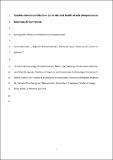Files in this item
Possible mineral contributions to the diet and health of wild chimpanzees in three East African forests
Item metadata
| dc.contributor.author | Reynolds, Vernon | |
| dc.contributor.author | Pascual-Garrido, Alejandra | |
| dc.contributor.author | Lloyd, Andrew W. | |
| dc.contributor.author | Lyons, Peter | |
| dc.contributor.author | Hobaiter, Catherine | |
| dc.date.accessioned | 2020-05-13T23:34:11Z | |
| dc.date.available | 2020-05-13T23:34:11Z | |
| dc.date.issued | 2019-05-14 | |
| dc.identifier | 259064507 | |
| dc.identifier | 18c6bda3-8086-40df-8dc0-ac4e23b47096 | |
| dc.identifier | 000475815100007 | |
| dc.identifier | 85069483858 | |
| dc.identifier.citation | Reynolds , V , Pascual-Garrido , A , Lloyd , A W , Lyons , P & Hobaiter , C 2019 , ' Possible mineral contributions to the diet and health of wild chimpanzees in three East African forests ' , American Journal of Primatology , vol. Early View , e978 . https://doi.org/10.1002/ajp.22978 | en |
| dc.identifier.issn | 0275-2565 | |
| dc.identifier.other | ORCID: /0000-0002-3893-0524/work/57821917 | |
| dc.identifier.uri | https://hdl.handle.net/10023/19937 | |
| dc.description | For financial support, the authors acknowledge the Mohamed bin Zayed Species Conservation Fund grant numbers 0925272, 10251055, 11252562, 12254904, the Royal Zoological Society of Scotland, the Leverhulme Trust grant number ECF‐2013‐507, and the Boise Fund. | en |
| dc.description.abstract | We present new data on the ingestion of minerals from termite mound soil by East African chimpanzees (Pan troglodytes schweinfurthii) living in the Budongo Forest Reserve, Uganda, the Gombe National Park and the Mahale Mountains National Park, Tanzania. Termite mound soil is here shown to be a rich source of minerals, containing high concentrations of iron and aluminum. Termite mound soil is not, however, a source of sodium. The concentrations of iron and aluminum are the highest yet found in any of the mineral sources consumed. Levels of manganese and copper, though not so high as for iron and aluminum, are also higher than in other dietary sources. We focus on the contribution of termite mound soil to other known sources of mineral elements consumed by these apes, and compare the mineral content of termite soil with that of control forest soil, decaying wood, clay, and the normal plant‐based chimpanzee diet at Budongo. Samples obtained from Mahale Mountains National Park and Gombe National Park, both in Tanzania, show similar mineral distribution across sources. We suggest three distinct but related mechanisms by which minerals may come to be concentrated in the above‐mentioned sources, serving as potentially important sources of essential minerals in the chimpanzee diet. | |
| dc.format.extent | 1300037 | |
| dc.language.iso | eng | |
| dc.relation.ispartof | American Journal of Primatology | en |
| dc.subject | Chimpanzees | en |
| dc.subject | Diet | en |
| dc.subject | Geography | en |
| dc.subject | Pan troglodytes | en |
| dc.subject | Tanzania | en |
| dc.subject | Termite mound soil | en |
| dc.subject | Minerals | en |
| dc.subject | Uganda | en |
| dc.subject | BF Psychology | en |
| dc.subject | NDAS | en |
| dc.subject.lcc | BF | en |
| dc.title | Possible mineral contributions to the diet and health of wild chimpanzees in three East African forests | en |
| dc.type | Journal article | en |
| dc.contributor.institution | University of St Andrews. Centre for Social Learning & Cognitive Evolution | en |
| dc.contributor.institution | University of St Andrews. School of Psychology and Neuroscience | en |
| dc.identifier.doi | 10.1002/ajp.22978 | |
| dc.description.status | Peer reviewed | en |
| dc.date.embargoedUntil | 2020-05-14 |
This item appears in the following Collection(s)
Items in the St Andrews Research Repository are protected by copyright, with all rights reserved, unless otherwise indicated.

